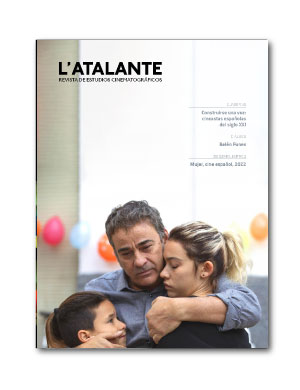Post-televisual Brushstrokes: 'Twin Peaks: The Return' and 'Too Old to Die Young' from the Perspective of “Pictorial Time”
Published 2022-01-30
Keywords
- Painting,
- Contemporary Serial Fiction,
- Time,
- Twin Peaks,
- The Return
- Too Old To Die Young,
- David Lynch,
- Nicolas Winding Refn,
- Jean-François Lyotard. ...More
How to Cite
Copyright (c) 2022 L'Atalante. Journal of film studies

This work is licensed under a Creative Commons Attribution-NonCommercial-NoDerivatives 4.0 International License.
Abstract
Just as they did in the 1990s, David Lynch and Mark Frost made an unexpected return to the small screen in recent years that called into question the prevailing artistic and narrative forms of contemporary serial fiction. Understanding Nicolas Winding Refn and Ed Brubaker’s Too Old To Die Young (Amazon Prime Video: 2019) as a successor in certain respects to Twin Peaks: The Return (David Lynch & Mark Frost, Showtime: 2017), this article offers a comparative analysis based on the theories of Gilles Deleuze and, especially, Jean-François Lyotard, related to “pictorial time”, with the aim of reappraising these forms of seriality, exploring the treatment of art and time in two series with unorthodox ways of conceiving plot continuity and shot duration, very far from the (still hegemonic) standards established by “quality TV”.
Downloads
References
Aumont, J. (1989). <em>L’Œil interminable : cinema et peinture</em>. Paris: Librairie Séguier.<br>
Bazin, A. (1990). <em>¿Qué es el cine?</em> Madrid: Rialp. <br>
Bazin, A. (2004). <em>What Is Cinema? Volume I.</em> Berkeley: University of California Press. <br>
Benjamin, W. (1989). <em>Discursos interrumpidos I</em>. Madrid: Taurus.<br>
Benjamin, W. (2019). <em>Illuminations: Essays and Reflections</em>. Boston: Houghton Mifflin Harcourt.<br>
Bonitzer, P. (1986). <em>Peinture et cinéma</em> :<em> décadrages</em>. Paris: Cahiers du cinéma, Editions de l’Etoile.<br>
Brenez, N. (1998). <em>De la figure en général et de corps particulière. L’invention figurative au cinéma</em>. Paris: DeBoeck Université.<br>
Butler, J. G. (2010). <em>Television Style</em>. New York: Routledge.<br>
Caldwell, J. T. (1995). <em>Televisuality: Style, Crisis, and Authority in American Television</em>. New Brunswick, NJ: Rutgers University Press.<br>
Carrión, J. (2011). <em>Teleshakespeare</em>. Madrid: Errata Naturae.<br>
Creeberg, G. (2013). <em>Small Screen Aesthetics: From TV to the Internet</em>. London: Palgrave Macmillan.<br>
Deleuze, G.(1968). <em>Différence et Répétition</em>. Paris: PUF.<br>
Deleuze, G. (1984). <em>La imagen-movimiento: Estudios sobre cine 1</em>. Barcelona: Paidós.<br>
Deleuze, G. (1987). <em>La imagen-tiempo. Estudios sobre cine 2</em>. Barcelona: Paidós.<br>
Deleuze, G. (2002). <em>La lógica de la sensación</em>. Madrid: Arena Libros. <br>
Deleuze, G., Guattari, F. (1980). <em>Mille plateaux. Capitalisme et schizophrénie</em>. Paris: Minuit.<br>
Durafour, J.-M. (2009). <em>Jean-François Lyotard: questions au cinéma</em>. Paris: PUF.<br>
Ellis, J. (2017). <em>Visible Fictions. Cinema, Television, Video</em>. London: Routledge.<br>
Fiske, J. (1987).<em> Television Culture</em>. London: Methuen.<br>
Jones, G., Woodward, A. (eds.) (2017). <em>Acinemas. Lyotard’s Philosophy of Film</em>. Edinburgh: Edinburgh University Press.<br>
Lessing, G. (1990). <em>Laocoonte</em>. Madrid: Tecnos. <br>
Lipovetsky, G. (2000). <em>La era del vacío: ensayos sobre el individualismo contemporáneo</em>. Barcelona: Anagrama. <br>
Lyotard, J.-F. (1971). <em>Discours, figure</em>. Paris: Klincksieck.<br>
Lyotard, J.-F. (1973). <em>Des dispositifs pulsionnels</em>. Paris: Galilée.<br>
Lyotard, J.-F. (1991). <em>The Inhuman: Reflections on Time</em>. Palo Alto, CA: Stanford University Press.<br>
Lyotard, J.-F. (1998). <em>Lo Inhumano: charlas sobre el tiempo</em>. Buenos Aires: Manantial.<br>
Lyotard, J.-F. (2000). <em>Misère de la philosophie</em>. Paris: Galilée.<br>
Mactaggart, A. (2010). <em>The Film Paintings of David Lynch: Challenging Film Theory</em>. Bristol: Intellect.<br>
Marcuse, H. (1972). <em>El hombre unidimensional</em>. Barcelona: Seix Barral.<br>
Martin, A. (2018). El reto de la narrativa. <em>Caimán cuadernos de cine</em>, <em>70</em>, 48-54.<br>
Metallinos, N. (1996). <em>Television Aesthetic: Perceptual, Cognitive, and Compositional Basis</em>. Mahwah, NJ: Lawrence Erlbaum Associates.<br>
Nannicelli, T. (2017). <em>Appreciating the Art of Television: A Philosophical Perspective.</em> New York: Routledge.<br>
Newcomb, H. (1974). <em>TV. The Most Popular Art</em>. New York: Anchor Books.<br>
Newman, B. (2003). The Sublime is Now. In C. Harrison & P. Wood (eds.), <em>Art in Theory 1900-2000: An Anthology of Changing Ideas</em> (pp. 572-574). Oxford: Blackwell Publishers.<br>
Rodley, C. (ed.) (2017). <em>David Lynch por David Lynch</em>. Buenos Aires: El cuenco de plata. <br>
Rosenberg, H. (1959). <em>The Tradition of the New</em>. New York: Horizon Press.<br>
Salvà, N. (2019, 15 June). Entrevista a Nicolas Winding Refn por el estreno en Amazon Prime de <em>Demasiado viejo para morir joven</em>. <em>El Periódico</em>. Retrieved from https://www.elperiodico.com/es/series/20190615/entrevista-nicolas-winding-refn-estre no-amazon-prime-demasiado-joven-para-morir-joven-7506353.<br>
Salvadó-Corretger, G., Benavente, F. (2021). Time to Dream, Time to Remember: Patterns of Time and Metaphysics in <em>Westworld</em>. <em>Television & New Media</em>, <em>22</em>(3), 262-280. https://doi.org/10.1177/1527476419894947.<br>
Tomassoni, I. (1968). <em>Pollock</em>. Sadea: Florencia.<br>
Vancheri, L. (2011). <em>Les pensées figurales de l’image</em>. Paris: Armand Colin.<br>
Wenders, W. (2016). <em>Los píxels de Cézanne y otras impresiones sobre mis afinidades artísticas</em>. Buenos Aires: Caja Negra.<br>
Williams, R. (1974). <em>Televisión. Technology and Cultural Form</em>. London: Fontana.</p>

